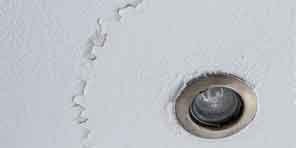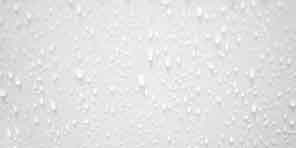St Louis - St Charles Insulation Company.


What Causes Condensation on Interior Walls?
Condensation gathers on interior walls of a home for many reasons, but we bet you don’t realize subpar wall insulation in St. Charles MO could be the culprit. You may have noticed wet walls in the winter when your heater kicks on, or even in summer when your AC starts up. Condensation isn’t good for your walls, and it isn’t good for your health either.
Plus, it’s pretty costly to replace drywall, then repaint everything. And if your smooth walls are wet, it’s a good chance that your furniture and carpeting is, too. And where moisture is, mold loves to grow.
Condensation happens when the air contains more moisture than it can reasonably hold. It then hits a saturation point that turns moisture back into water, leading to condensation. The temperature at saturation point is known as the dew point.
Temperature Differences
If you notice large temperature difference between the outdoors and the inside of your home, and you start to see condensation on the walls, it’s a safe bet that you’re lacking insulation inside those walls. While you may not see drops running down your walls, you may notice that they are damp or moist.
Don’t ignore this problem and chalk it up to extreme temperature differences. This is an abnormal occurrence that needs to be addressed right away. It’s more common to see this happen in the winter when it’s frigid outside but the air inside is very warm. It happens in summer to some degree but the temperature extreme isn’t quite so vast. In summer, it may be 90 outside but 70 inside thanks to AC. But in the winter, it could be 70 inside with the heat on, yet 20 degrees outside.
The dew point is where the condensation forms, which is usually on the warmer side of the wall. And you’ll also find more condensation in the corners of the room where the insulation isn’t as thick.
Many types of insulation, such as insulation don’t create an air seal and don’t provide much insulation coverage, especially over time.
In summer months, you may spot mildew spores at the floor and in corners. If you tend to take a lot of long, hot showers or you boil a lot of water for cooking without any ventilation, this problem can worsen.
Preventing Condensation
The best way to prevent condensation on interior walls is to update your insulation, add more, or remove and replace. It’s best to try drill & fill for older homes spray foam for new homes this time around, which adheres to every nook and cranny with no gaps. Getting an insulation consultation is your best course of action, as trusted professionals can tell you what the culprit is and how to remedy it.
insulation
Call Addict Insulation In Missouri
If you have been noticing condensation on your interior walls, it’s time to schedule your no-cost consultation with our St. Charles insulation contractors today. Just contact us in St. Louis MO or St. Charles MO at 636-233-7314.
Energy Saving BlogMissouri Insulation Company
Popular Articles
- FAQs About Insulation in Missouri
- What Areas Should You Insulate Before Winter?
- The Greatest Risks to Your Home Caused by Poor Insulation
- Why Your Utility Bills Are So High and What You Can Do About It
- Can You Put New Insulation Over Old?
- Here Are 3 Ways Your Attic Could be Contaminated
- How Home Insulation Works in the Summer
- Tips and Tricks For Summer Insulation
- How to Fix Indoor Condensation
- Choosing the Right Spray Foam Contractor
- Why You Need Power Washing This Spring
- Don't Let Air Escape Your Home
- Tips For Saving on Your Energy Bills This Summer
- Should I Install a Radiant Barrier in My Home?
- Are You Wondering if Your Attic Has Enough Insulation?
- Do I Have to Replace Wet Insulation?
- Insulating Your Sunroom
- Should You Insulate Your Outdoor Spaces?
- All About Removing Insulation
- What to Know About Insulating a Crawl Space
- How to Spot Mold in Your Wall Insulation
- How to Prevent Moisture in Your Warehouse With Spray Foam Insulation
- What Factors Cause Heat Gain?
- The Problems That Come With Improper Insulation
- Insulation FAQs
- Why Should You Check the Insulation When Buying a Home?
- Why Seal and Insulate Your Home?
- Home Insulation: Safety and Health
- Should You Remove Old Insulation During Replacement?
- Can I Stay Inside My Home During Spray Foam Insulation Installation?
- Pros and Cons of Converting an Attic
- Pros and Cons of Converting an Attic
- When’s the Best Time to Insulate Your House?
- The Difference Between Blown Insulation and Spray Foam Insulation
- Is Your Garage Loft Too Hot or Too Cold? Heed These Tips
- 6 Health Benefits of Having a Quiet Home
- Insulation Prep is Critical For Installation
- The Dangers of Removing Insulation on Your Own
- What’s the Most Eco-Friendly Insulation?
- 7 Benefits of Spray Foam Insulation
- What is the Proper Insulation For Vaulted Ceilings?
- Signs Your Crawlspace Insulation Should be Replaced
- Why You Should Insulate Your Basement Walls
- Most Effective Ways to Soundproof Your Home Office
- How to Insulate an Old House
- 4 Tips to Make Your Attic More Energy Efficient
- Attic Insulation Problems: 5 Things to Look Out For
- What Causes Condensation on Interior Walls?
- How Deep Should Your Insulation Be?
- What to Consider When Choosing an Insulation Company
- Can You Add New Insulation Layers Over Old Ones?
- When Should You Remove Insulation?
- 7 Tips For an Energy Efficient Summer
- Creating a Healthy, Comfortable and Productive Workspace When Working From Home
- Why is Roof Ventilation Just as Important as Insulation?
- Why Spring is a Good Time to Insulate Your Attic
- 5 Signs of Damaged or Insufficient Insulation
- Is the Insulation in Your Walls Making You Sick?
- Under-Insulated Areas You May Be Overlooking
- The History Of Insulation.
- Pros and Cons of Attic Insulation
- Do You Need Insulation When Finishing a Basement?
- What is Drill and Fill Insulation?
- Which Insulation is Best for Garage Walls?
- How Air is Escaping Your Home and How to Prevent It
- 10 Things You Must Absolutely Insulate Before Winter
- 5 Reasons To Not DIY Insulation
- 5 Signs of an Under-Insulated Home
- 5 Benefits of Blown Insulation
- Cellulose vs. Fiberglass Insulation
- When is Insulation Removal Necessary?
- Tips to Keep Your Home Cool This Summer
- What is the Best Insulation for a Flat Roof?
- 5 Benefits of Power Washing
- Q & A About Insulation
- Reviews
- Energy Saving Blog






